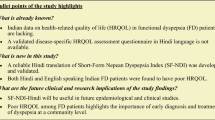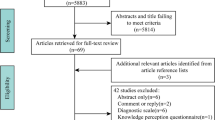Abstract
Assessment of symptoms should be one of the main outcome measures in dyspepsia clinical trials. This requires a reliable, valid and responsive questionnaire that measures the frequency and severity of dyspeptic symptoms. The Short-Form Leeds Dyspepsia Questionnaire (SF-LDQ) has been proven to fulfil these criteria in its original version in the English language. The aim of the study was to assess the internal consistency, reliability, validity and responsiveness of the Italian version of the SF-LDQ in primary and secondary care. Unselected primary and secondary care patients completed the Italian version of the SF-LDQ. Test–retest reliability was assessed after 2 days. Validity was measured by comparison with diagnosis made by physicians. Responsiveness was determined before and after treatment for endoscopically proven disease. The SF-LDQ was administered to 311 patients in primary care and 179 in secondary care patients. Internal consistency, as judged by the Cronbach’s α, was 0.90. Pearson’s correlation coefficient for test–retest reliability was 0.92. The SF-LDQ had a sensitivity of 80% and a specificity of 82%. A highly significant response to change was also observed (p = 0.001). The Italian SF-LDQ is a reliable, valid and responsive self-completed outcome measure for quantifying the frequency and severity of dyspeptic symptoms.



Similar content being viewed by others
References
Tack J, Talley NJ, Camilleri M et al (2006) Functional gastroduodenal disorders. Gastroenterology 130:1466–1479
Moayyedi P, Forman D, Braunholtz D et al (2000) The proportion of upper gastrointestinal symptoms in the community associated with Helicobacter pylori, lifestyle factors, and nonsteroidal anti-inflammatory drugs. Leeds HELP Study Group. Am J Gastroenterol 95:1448–1455
Talley NJ (2002) Dyspepsia: management guidelines for the millennium. Gut 50(Suppl 4):iv72–iv78, discussion iv79
Agreus L (2002) Natural history of dyspepsia. Gut 50(Suppl 4):iv2–iv9
Delaney B, Moayyedi P, Deeks J et al (2000) The management of dyspepsia: a systematic review. Health Technol Assess 4:iii–v, 1–189
Talley NJ (2002) Dyspepsia: management guidelines for the millennium. Gut 50(Suppl 4):iv72–iv78, discussion iv9
McColl E (2004) Best practice in symptom assessment: a review. Gut 53(Suppl 4):iv49–iv54
Talley NJ (1994) A critique of therapeutic trials in Helicobacter pylori-positive functional dyspepsia. Gastroenterology 106:1174–1183
McColl E, Junghard O, Wiklund I et al (2005) Assessing symptoms in gastroesophageal reflux disease: how well do clinicians’ assessments agree with those of their patients? Am J Gastroenterol 100:11–18
Moayyedi P, Duffett S, Braunholtz D et al (1998) The Leeds Dyspepsia Questionnaire: a valid tool for measuring the presence and severity of dyspepsia. Aliment Pharmacol Ther 12:1257–1262
Fraser A, Delaney B, Moayyedi P (2005) Symptom-based outcome measures for dyspepsia and GERD trials: a systematic review. Am J Gastroenterol 100:442–452
Shaw MJ, TalleyNJ, Beebe TJ et al (2001) Initial validation of a diagnostic questionnaire for gastroesophageal reflux disease. Am J Gastroenterol 96:52–57
Fraser A, Delaney BC, Ford AC et al (2007) The Short-Form Leeds Dyspepsia Questionnaire validation study. Aliment Pharmacol Ther 25:477–486
Stanghellini V (1999) Three-month prevalence rates of gastrointestinal symptoms and the influence of demographic factors: results from the Domestic/International Gastroenterology Surveillance Study (DIGEST). Scand J Gastroenterol Suppl 231:20–28
Bland JM, Altman DG (1997) Cronbach’s alpha. BMJ 314:572
Newcombe R, Altman D (2000) Proportion and their differences. In: Altman D, Machin D, Trevor N, Gardner M (eds) Statistics with confidences. BMJ Books, London, pp 45–56
Dent J (2002) Definitions of reflux disease and its separation from dyspepsia. Gut 50(Suppl 4):iv17–iv20, discussion iv1–iv2
Buckley MJ, Scanlon C, McGurgan P et al (1997) A validated dyspepsia symptom score. Ital J Gastroenterol Hepatol 29:495–500
Greatorex R, Thorpe JA (1983) Clinical assessment of gastro-oesophageal reflux by questionnaire. Br J Clin Pract 37:133–135
Junghard O, Lauritsen K, Talley NJ et al (1998) Validation of seven graded diary cards for severity of dyspeptic symptoms in patients with non-ulcer dyspepsia. Eur J Surg Suppl (583):106–111
Locke GR, Talley NJ, Weaver AL et al (1994) A new questionnaire for gastroesophageal reflux disease. Mayo Clin Proc 69:539–547
Phillips SF, Talley NJ, Wiltgen CM et al (1990) Assessment of functional gastrointestinal disease: the bowel disease questionnaire. Mayo Clin Proc 65:1456–1479
Hu WH, Lam KF, Wong YH et al (2002) The Hong Kong index of dyspepsia: a validated symptom severity questionnaire for patients with dyspepsia. J Gastroenterol Hepatol 17:545–551
Dimenas E, Glise H, Hallerback B et al (1993) Quality of life in patients with upper gastrointestinal symptoms. An improved evaluation of treatment regimens? Scand J Gastroenterol 28:681–687
Shaw M, Talley NJ, Adlis S et al (1998) Development of a digestive health status instrument: tests of scaling assumptions, structure and reliability in a primary care population. Aliment Pharmacol Ther 12:1067–1078
Goldman J, Conrad DF, Ley C et al (2002) Validation of Spanish language dyspepsia questionnaire. Dig Dis Sci 47:624–640
Garratt AM, Ruta DA, Russell I et al (1996) Developing a condition-specific measure of health for patients with dyspepsia and ulcer-related symptoms. J Clin Epidemiol 49:565–571
Eypasch E, Williams JI, Wood-Dauphinee S et al (1995) Gastrointestinal Quality of Life Index: development, validation and application of a new instrument. Br J Surg 82:216–222
Leidy NK, Farup C, Rentz AM et al (2000) Patient-based assessment in dyspepsia: development and validation of Dyspepsia Symptom Severity Index (DSSI). Dig Dis Sci 45:1172–1179
Rabeneck L, Wristers K, Goldstein JL et al (2002) Reliability, validity, and responsiveness of severity of dyspepsia assessment (SODA) in a randomized clinical trial of a COX-2-specific inhibitor and traditional NSAID therapy. Am J Gastroenterol 97:32–39
Vakil N, van Zanten SV, Kahrilas P et al (2006) The Montreal definition and classification of gastroesophageal reflux disease: a global evidence-based consensus. Am J Gastroenterol 101:1900–1920
Conflict of interest
Dino Vaira has stock options (other than mutual funds) in Meridian Bioscience. Other authors have no conflict of interest.
Author information
Authors and Affiliations
Corresponding author
Rights and permissions
About this article
Cite this article
Gatta, L., Moayyedi, P., Tosetti, C. et al. A validation study of the Italian Short-Form Leeds Dyspepsia Questionnaire. Intern Emerg Med 5, 501–506 (2010). https://doi.org/10.1007/s11739-010-0467-5
Received:
Accepted:
Published:
Issue Date:
DOI: https://doi.org/10.1007/s11739-010-0467-5




